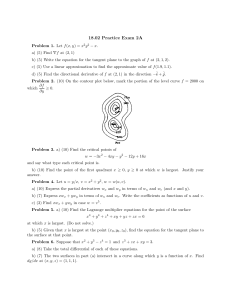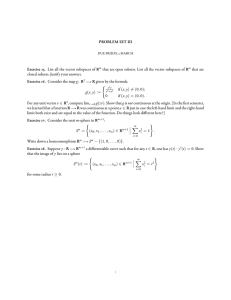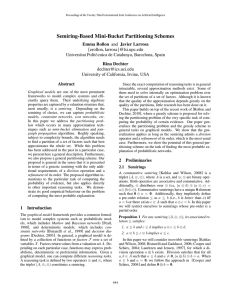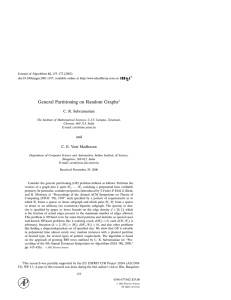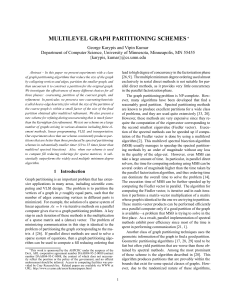Lecture 4 4.1 Corrections to Problem Set
advertisement
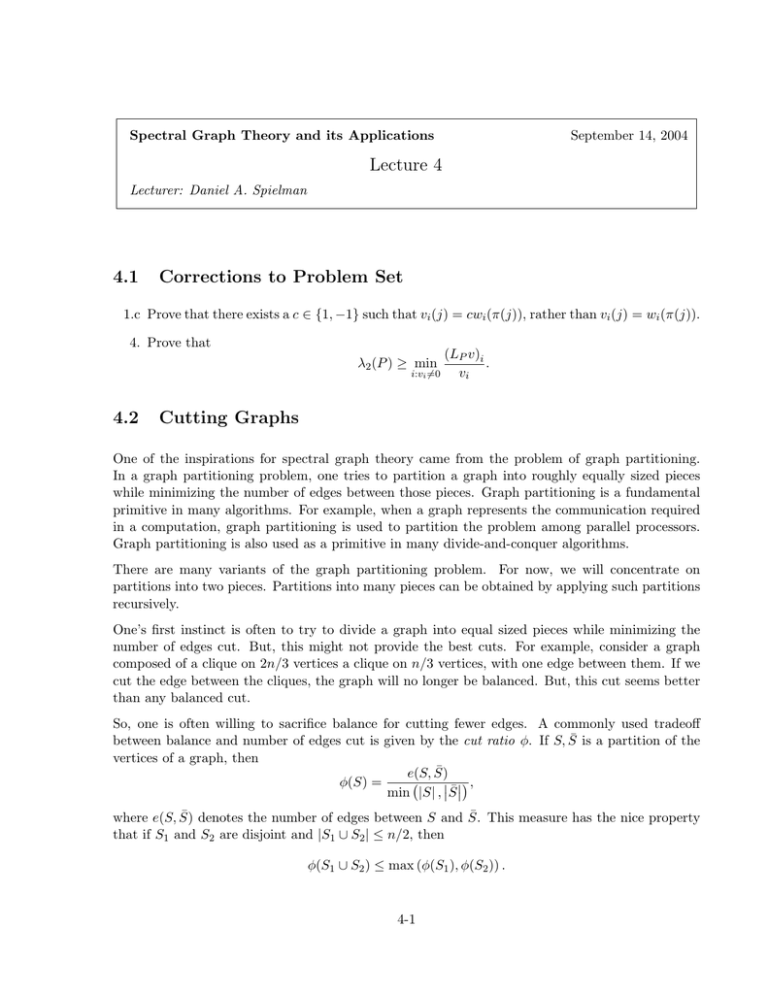
Spectral Graph Theory and its Applications
September 14, 2004
Lecture 4
Lecturer: Daniel A. Spielman
4.1
Corrections to Problem Set
1.c Prove that there exists a c ∈ {1, −1} such that vi (j) = cwi (π(j)), rather than vi (j) = wi (π(j)).
4. Prove that
(LP v)i
.
i:vi =0
�
vi
λ2 (P ) ≥ min
4.2
Cutting Graphs
One of the inspirations for spectral graph theory came from the problem of graph partitioning.
In a graph partitioning problem, one tries to partition a graph into roughly equally sized pieces
while minimizing the number of edges between those pieces. Graph partitioning is a fundamental
primitive in many algorithms. For example, when a graph represents the communication required
in a computation, graph partitioning is used to partition the problem among parallel processors.
Graph partitioning is also used as a primitive in many divide-and-conquer algorithms.
There are many variants of the graph partitioning problem. For now, we will concentrate on
partitions into two pieces. Partitions into many pieces can be obtained by applying such partitions
recursively.
One’s first instinct is often to try to divide a graph into equal sized pieces while minimizing the
number of edges cut. But, this might not provide the best cuts. For example, consider a graph
composed of a clique on 2n/3 vertices a clique on n/3 vertices, with one edge between them. If we
cut the edge between the cliques, the graph will no longer be balanced. But, this cut seems better
than any balanced cut.
So, one is often willing to sacrifice balance for cutting fewer edges. A commonly used tradeoff
between balance and number of edges cut is given by the cut ratio φ. If S, S¯ is a partition of the
vertices of a graph, then
e(S, S¯)
� �� ,
�
φ(S) =
¯
�
min |
S | , �S
¯
This measure has the nice property
where e(S, S̄) denotes the number of edges between S and
S.
that if S1 and S2 are disjoint and |S1 ∪ S2 | ≤ n/2, then
φ(S1 ∪ S2 ) ≤ max (φ(S1 ), φ(S2 )) .
4-1
Lecture 4: September 14, 2004
4-2
The cut of minimum ratio is given by the set S minimizing φ(S). The quality of this cut is called
the isoperimetric number of the graph, and is given by
def
φ(G) = min φ(S).
S⊂V
4.3
An integer program
Donnath and Hoffman (check it was them) proposed approximating φ(G) be the following integer
program:
�
2
(i,j)∈E (xi − xj )
�
min
.
(4.1)
2
x∈{0,1}n
i<j (xi − xj )
If we set x to be �the
� characteristic vector of a set S, then the numerator is e(S, S̄) and the
denominator is |S| �S¯�. So, the value of (4.1) lies between φ(G)/n and φ(G)/(n/2). Thus, if we
could solve (4.1), we could approximate the isoperimetric number of a graph to within a factor of
2.
However, there is no easy way to solve this integer program. So, we will relax the program to obtain
one that we can solve. Instead of restricting x to be 0 or 1, we could let each xi lie in the interval
[0, 1]. As we will see momentarily, we can solve the resulting program. We should note that making
this relaxation allows us to obtain a lower minimum. However, it is not clear how much lower it
can be. It is also not clear whether we can use the vector x we obtain to find a good partition.
To see that we can solve this program, first note that multplying x by any constant does not change
the value of the ratio. So, we may as well let x − I lie in [0, ∞). Second, replacing x by x + c for
any c ∈ IR leaves both the numerator and denominator unchanged.
So, we can let x be any vector
�
n
in IR . Without loss of generality, we can choose x so that i xi = 0. We can then simplify the
denominator by observing
�
��
2
(xi − xj )2 =
(x2i − 2xi xj + x2j )
i<j
i
j=i
�
�
�
�
= 2(n − 1)
x2i
−2
i
= 2(n − 1)
�
�
= 2n
xi
�
xj
j=i
�
i
�
x2i
i
�
�
+2
�
xi2
i
x2i .
i
So, we find that the value of the relaxed program is λ2 /n:
�
�
�
2
2
2
(i,j)∈E (xi − xj )
(i,j)∈E (xi − xj )
(i,j)∈E (xi − xj )
�
�
min n �
.
≥
min
=
min
= λ2 /n.
2
2
x∈IRn
n i x2i
x∈{0,1}
x∈IRn ,x⊥1
i<j (xi − xj )
i<j (xi − xj )
Thus, we find that
φ(G) ≥ λ2 /2.
Lecture 4: September 14, 2004
4.4
4-3
Cheeger’s Inequality
We now address the question of how well λ2 /2 approximates φ(G), and whether or not we can
find a good partition from v2 , the corresponding eigenvector. The first question is addressed by
a discrete version of Cheeger’s inequality, proved by Jerrum and Sinclair (and Alon, and Diaconis
and Strook?):
φ2
λ2 ≥
,
2dmax
where dmax is the maximum degree of a vertex in the graph. The proof of the discrete Cheeger
inequality also yields a partition.
However, exactly computing eigenvectors is a pain. So, we will prove a theorem of Mihail that finds
a cut from any test vector. In particular, the cut will consist of all vertices i such that xi < t for
some threshold t.
Theorem 4.4.1. Let x ⊥ 1 and assume, without loss of generality, that x1 ≤ x2 ≤ · · · ≤ xn . Then,
for some i,
xT Lx
φ ({1, . . . , i})2
≥
,
xT x
2dmax
where dmax is the maximum degree of a vertex in the graph.
A proof of this theorem may be found at
http://www-math.mit.edu/~spielman/AEC/lect5.ps
MIT OpenCourseWare
http://ocw.mit.edu
18.409 Topics in Theoretical Computer Science: An Algorithmist's Toolkit
Fall 2009
For information about citing these materials or our Terms of Use, visit: http://ocw.mit.edu/terms.



